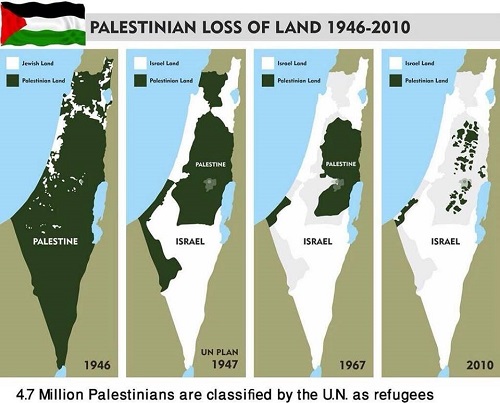Understanding the Current Violence
in Palestine and Israel
Dana April Seidenberg
Dana is a Syracusan who is passionate about justice for Palestine.
Heart-wrenching scenes of human suffering darken our spectacular autumn as daily headlines in the local press telescope in on Palestinian violence against Israelis, characterized as lone-wolf attacks. Of course Palestinians– often mere teenagers— with their knives and stones are no match for the well-equipped Israeli army who respond with live fire and tear gas. These so-called ‘terrorists” are doomed: they are either killed on the spot or taken prisoner.
Control over the site of the Al-Aqsa Mosque/Temple Mount is often cited as the irritant in this latest round of violence in a conflict with seemingly no end in sight. The Al-Aqsa Mosque—among Islam’s holiest sites—was built over the ruins of the sacred Jewish Temple destroyed by Roman forces in antiquity. But the mainstream media fail to see the big picture and provide the true context of the conflict.

Where History Went Wrong
Admirers of Israel and Zionism conveniently overlook the origins and evolution of that nation-state as well as the plight of the Palestinians who for centuries have lived on that land. Like other late-l9th century colonial projects, Zionism began in Europe. With Jews facing increased anti-semitism in Europe and the coming of World War I, Jewish communities wanted out.
A trickle went first to Kenya, but on the advice of Zionist leaders, others migrated to Palestine. “A land without a people for a people without a land” was a familiar colonial mantra for advancing a possible project in Palestine. There was one problem. Hidden in plain sight was Historic Palestine, already inhabited by those who had lived there for generations and were not about to surrender it to colonizers.
By l948 a war between the new settlers and the natives led to the ethnic cleansing of Palestinians. The well-armed settlers razed hundreds of Palestinian villages, forcing 700,000 people into exile where they remain to this day in refugee camps in Lebanon, Syria and Jordan or inside Palestine on the West Bank and Gaza. This settler movement occupying Palestine as a colonial state continues to thrive with the support of the United States and the European Union, with $3 billion dollars of US taxpayer money flowing annually to the brutal Israeli military.
In Solidarity
It is axiomatic that oppression always brings forth resistance. By the l930s, local uprisings against Britain’s colonial Mandate in Palestine had begun as did struggles against imperial powers in other occupied countries around the Mediterranean rim, Africa and elsewhere. In Palestine, the scenes we witness every day through our media are Arab inhabitants of the land fighting an ongoing colonial war for the liberation of their country.
In 2005, Palestinian civil society, represented by 171 unions, associations and organizations, asked people of conscience around the world who wish to support Palestinian freedom to become active in a Boycott, Divestment and Sanctions (BDS) movement against the Israeli government until it ends its occupation and recognizes the right of Palestinian refugees to return to their homes.
Inspired by South Africans’ struggle against apartheid, Palestinians are asking the international community to promote boycotts of companies that are profiting from Israel’s brutal occupation of Palestine. Some targeted companies include firms like RE/Max, which sells real estate in West Bank settlements; G4S, which provides security services in Israeli prisons and checkpoints (and, incidentally, at our own Hancock airport); and defense contractor Lockheed Martin, which produces the F-16 jets that have been used by Israel in its assaults on the Gaza strip. Lockheed Martin, which also develops drones and produces missiles for them, has a large plant in the Syracuse suburbs.
Another Vision for Peace
On October 27, at ArtRage Gallery in Syracuse, we had the good fortune to hear the generous thoughts of Palestinian physician and author Abdul Karim Al Makadma. His hope is for an inclusive democratic secular state in all of Historic Palestine embedded in the very same principles enjoyed by many here in the US. In 1948 he and his family fled out of Beit Daras, a village near Jerusalem surrounded by olive groves, to Gaza where the al-Shati refugee camp was home.
Abdul Karim supports one state as “we are one people.” With Israeli settlements throughout the West Bank since 1967, the old two-state solution is no longer feasible. He adds: “What an incredible nation we could build together, Jews and Muslims and Christians, Palestinians all, if we worked as one in cooperation and peace.” In Martin Luther King Jr.’s famous phrase: “The arc of freedom bends in the direction of justice.” The effort needed to bend the arc is in our hands.





